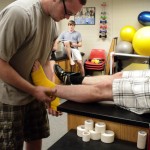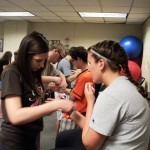 Active learning is a term used to describe teaching methodologies designed to promote a deeper form of learning than when compared to hearing a lecture. Active learning provides students with an opportunity to develop reflective understanding of course material by transferring new knowledge into practice among peers.
Active learning is a term used to describe teaching methodologies designed to promote a deeper form of learning than when compared to hearing a lecture. Active learning provides students with an opportunity to develop reflective understanding of course material by transferring new knowledge into practice among peers.
This way of teaching has enjoyed significant research support as first studied by Chickering and Gamson in the late 1980s in their work titled: “Seven Principles for Good Practice in Undergraduate Education.” The technique provides a supportive environment and encourages contact among students from different backgrounds. It is not passive.
In my classes, I create opportunities where students construct their understanding through these active learning interactions with their peers (and with me). In one example, I assigned my athletic training students to first research, and then demonstrate several common athletic training techniques to peers. My role was to mentor each student based on their individual strengths and weaknesses. Being a smaller class, I was able to provide very detailed and insightful feedback for each student — feedback that I am not always able to do at the same detailed level with my larger classes.
Using a scoring rubric to access performance, each student was given the task of properly demonstrating various athletic training techniques as depicted in the photos below. Some of the learning objectives included being able to: 1) Properly fit a football helmet, 2) Palpation of soft tissue, ligamentous, and bony landmarks about the shoulder, 3) Proper fitting and application options for the SAM splint, 4) Open basket weave ankle taping, 5) Thumb taping, 6) Ankle stability exercises following injury, 7) crutch fitting and walking
Not only is active learning an important part of undergraduate education, it is also a common practice among allied health schools such as nursing, physical therapy and athletic training as well as medical school curricula. Generally, this learning model includes clinical instruction in which a local professional is selected by the educational program to serve as a Preceptor (sometimes called a Clinical Instructor) for the students so that they may become accustomed to working in the field. These professionals then provide instruction and opportunities for the student to develop clinical integration proficiencies, communication skills and clinical decision-making during actual patient/client care clinical assignments.
In a classroom setting however, (rather than the clinical setting), the role of the professor is different than the preceptor’s role because there are no real patients. In many ways, active learning is sometimes related to the term “Flipping the Classroom” in which the professor serves as a tutor for students who prepare for class in advance by researching and studying material from various media in order to solve particular problem sets (designed by the professor) when they arrive to the classroom for class.



















